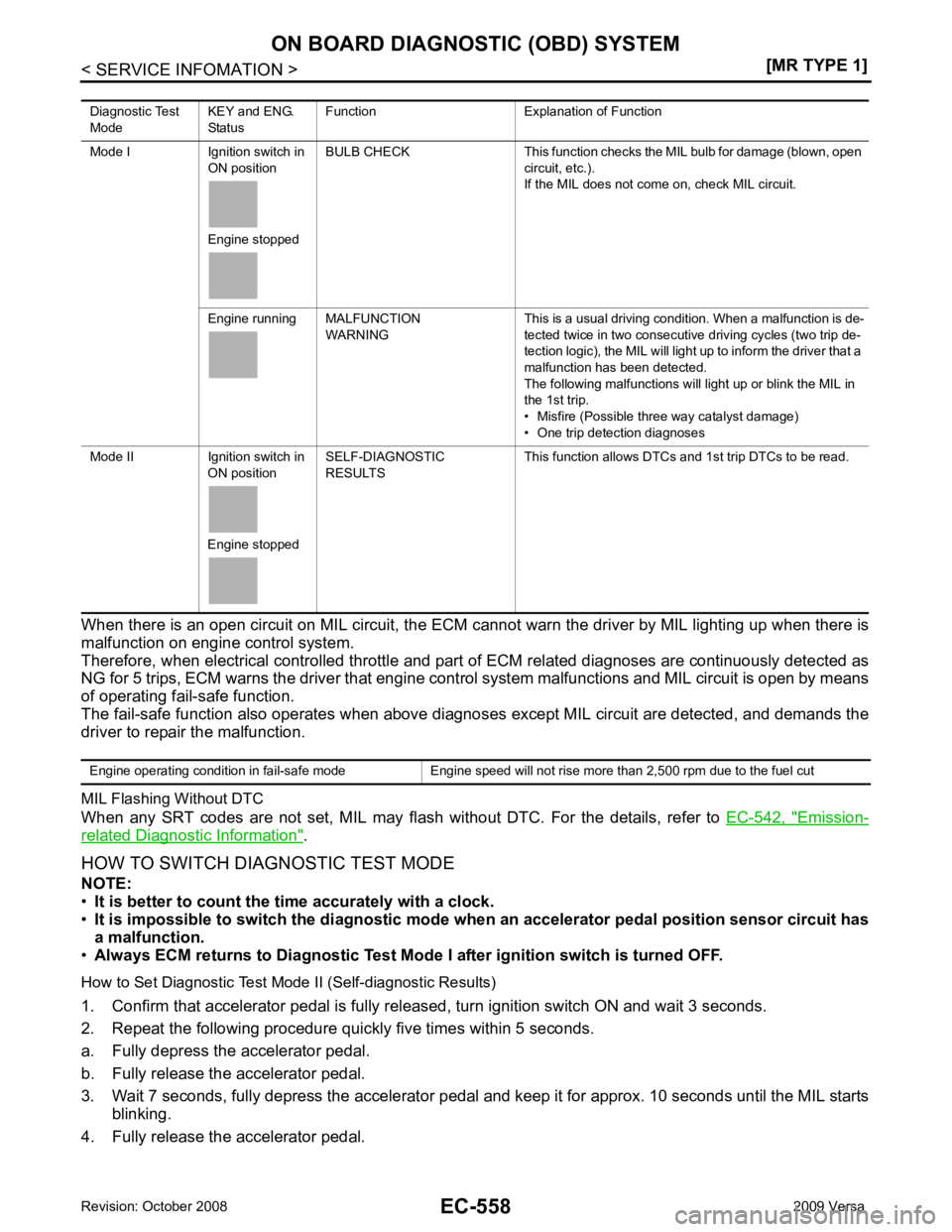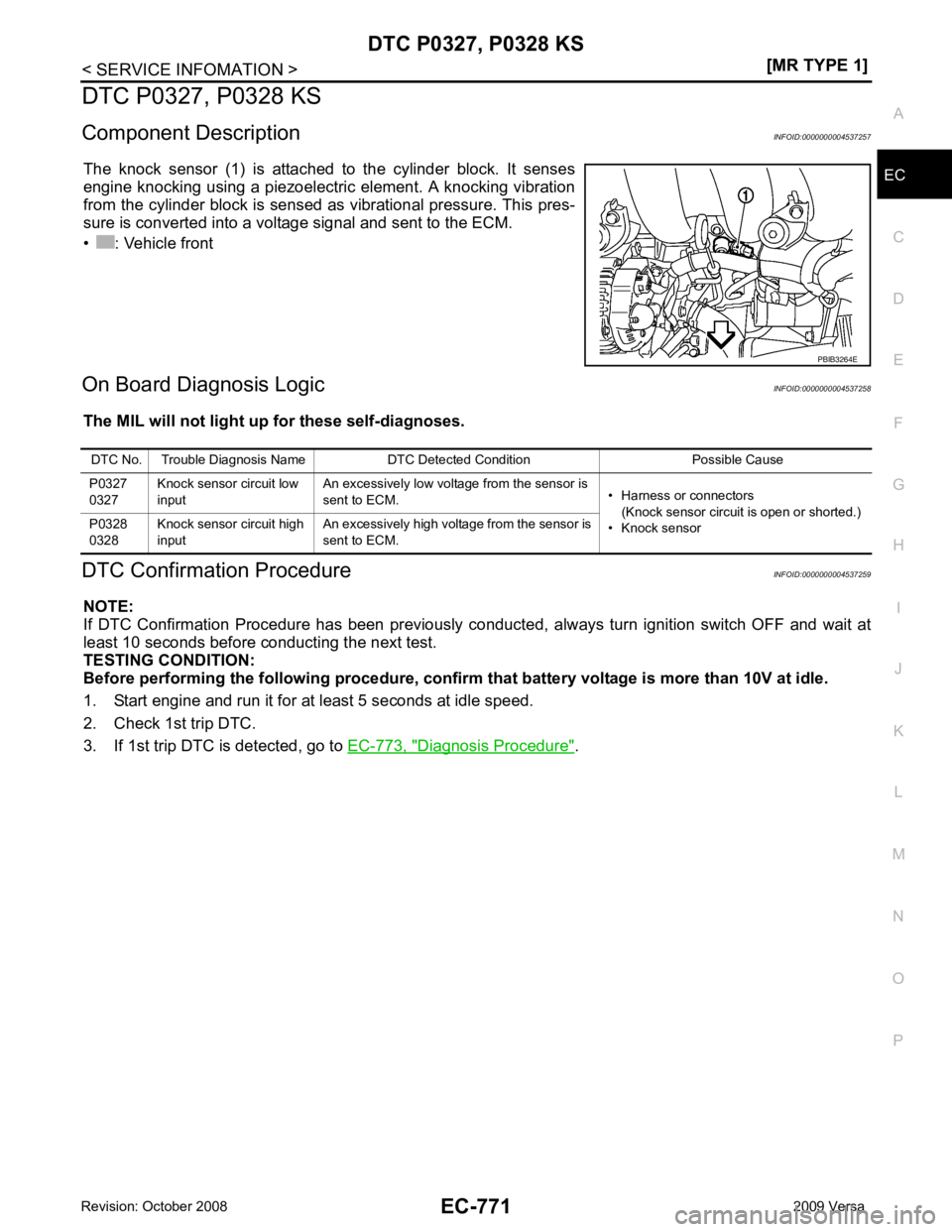2009 NISSAN TIIDA lock
[x] Cancel search: lockPage 1900 of 4331

(A/T),
CVT-258 (CVT)
ENGINE SPEED SIG P0725 0725 — 2 ×CVT-263 A/T 1ST GR FNCTN P0731 0731 — 2
×AT-110 A/T 2ND GR FNCTN P0732 0732 — 2
×AT-113 A/T 3RD GR FNCTN P0733 0733 — 2
×AT-116 A/T 4TH GR FNCTN P0734 0734 — 2
×AT-119 TCC SOLENOID/CIRC P0740 0740 — 2
×AT-124 A/T TCC S/V FNCTN P0744 0744 — 2
×AT-129 (A/T),
CVT-271 (CVT)
L/PRESS SOL/CIRC P0745 0745 — 2 ×CVT-273 PRS CNT SOL/A FCTN P0746 0746 — 1
×CVT-278 SFT SOL A/CIRC P0750 0750 — 1
×AT-139 SFT SOL B/CIRC P0755 0755 — 1
×AT-144 PRS CNT SOL/B FCTN P0776 0776 — 2
×CVT-280 PRS CNT SOL/B CIRC P0778 0778 — 2
×CVT-282 TR PRS SENS/A CIRC P0840 0840 — 2
×CVT-287 TR PRS SENS/B CIRC P0845 0845 — 2
×CVT-119 P-N POS SW/CIRCUIT P0850 0850 — 2
×EC-879 CLOSED LOOP-B1 P1148 1148 — 1
×EC-885 ENG OVER TEMP P1217 1217 — 1
×EC-886 CTP LEARNING-B1 P1225 1225 — 2 —
EC-895CTP LEARNING-B1 P1226 1226 — 2 —
EC-897COLD START CONTROL P1421 1421 — 2
×EC-899 ASCD SW P1564 1564 — 1 —
EC-901ASCD BRAKE SW P1572 1572 — 1 —
EC-907ASCD VHL SPD SEN P1574 1574 — 1 —
EC-916LOCK MODE P1610 1610 — 2 —
BL-259ID DISCORD,IMMU-ECM P1611 1611 — 2 —
BL-259CHAIN OF ECM-IMMU P1612 1612 — 2 —
BL-259CHAIN OF IMMU-KEY P1614 1614 — 2 —
BL-259DIFFERENCE OF KEY P1615 1615 — 2 —
BL-259TP SEN/CIRC A/T P1705 1705 — 1
×CVT-299 IN PULY SPEED P1715 1715 — 2 —
EC-918 (A/T),
EC-919 (CVT)
LU-SLCT SOL/CIRC P1740 1740 — 2 ×CVT-306 O/R CLTCH SOL/CIRC P1760 1760 — 2
×AT-149 STEP MOTR CIRC P1777 1777 — 1
×CVT-311 STEP MOTR FNC P1778 1778 — 2
×CVT-315 BRAKE SW/CIRCUIT P1805 1805 — 2 —
EC-921ETC MOT PWR-B1 P2100 2100 — 1
×EC-925 ETC FNCTN/CIRC-B1 P2101 2101 — 1
×EC-929 ETC MOT PWR P2103 2103 — 1
×EC-925 Items
(CONSULT-III screen terms) DTC*
1
SRT code Trip MIL lighting up Reference page
CONSULT-III
GST* 2
ECM*3
Page 1914 of 4331

Emission-
related Diagnostic Information " .
HOW TO SWITCH DIAGNOSTIC TEST MODE
NOTE:
• It is better to count the ti me accurately with a clock.
• It is impossible to switch the di agnostic mode when an accelerator pedal position sensor circuit has
a malfunction.
• Always ECM returns to Diagnostic Test Mode I after ignition switch is turned OFF.
How to Set Diagnostic Test Mode II (Self-diagnostic Results)
1. Confirm that accelerator pedal is fully releas ed, turn ignition switch ON and wait 3 seconds.
2. Repeat the following procedure quickly five times within 5 seconds.
a. Fully depress the accelerator pedal.
b. Fully release the accelerator pedal.
3. Wait 7 seconds, fully depress the accelerator pedal and keep it for approx. 10 seconds until the MIL starts blinking.
4. Fully release the accelerator pedal. Diagnostic Test
Mode KEY and ENG.
Status Function Explanation of Function
Mode I Ignition switch in ON position
Engine stopped BULB CHECK This function checks the MIL bulb for damage (blown, open
circuit, etc.).
If the MIL does not come on, check MIL circuit.
Engine running MALFUNCTION WARNING This is a usual driving condition. When a malfunction is de-
tected twice in two consecutive driving cycles (two trip de-
tection logic), the MIL will light up to inform the driver that a
malfunction has been detected.
The following malfunctions will light up or blink the MIL in
the 1st trip.
• Misfire (Possible three way catalyst damage)
• One trip detection diagnoses
Mode II Ignition switch in ON position
Engine stopped SELF-DIAGNOSTIC
RESULTS This function allows DTCs an
d 1st trip DTCs to be read.
Page 1929 of 4331
![NISSAN TIIDA 2009 Service Repair Manual EC
NP
O
[Air conditioner, headlamp, rear window defogger]
On vehicles equipped with daytime light systems, if the parking brake is applied before the engine is
started the headlamp will not be illumi NISSAN TIIDA 2009 Service Repair Manual EC
NP
O
[Air conditioner, headlamp, rear window defogger]
On vehicles equipped with daytime light systems, if the parking brake is applied before the engine is
started the headlamp will not be illumi](/manual-img/5/57398/w960_57398-1928.png)
EC
NP
O
[Air conditioner, headlamp, rear window defogger]
On vehicles equipped with daytime light systems, if the parking brake is applied before the engine is
started the headlamp will not be illuminated.
• Steering wheel: Neutral (Straight-ahead position)
• Vehicle speed: Stopped
• Transmission: Warmed-up
- Models with CONSULT-III (A/T and CVT models)
• Drive vehicle until “FLUID TEMP SE” in “DATA MONI TOR” mode of “A/T” or “CVT” system indicates less
than 0.9V.
- Models without CONSULT-III (A/T and CVT models) and M/T models
• Drive vehicle for 10 minutes.
OPERATION PROCEDURE
With CONSULT-III
1. Perform EC-572, " Accelerator Pedal Released Position Learning " .
2. Perform EC-572, " Throttle Valve Closed Position Learning " .
3. Start engine and warm it up to normal operating temperature.
4. Check that all items listed under the topic PREP ARATION (previously mentioned) are in good order.
5. Select “IDLE AIR VOL LEA RN” in “WORK SUPPORT” mode.
6. Touch “START” and wait 20 seconds.
7. Make sure that “CMPLT” is displayed on CONSULT-III screen. If “CMPLT” is not displayed, Idle Air Vol-
ume Learning will not be carried out successfully. In this case, find the cause of the incident by referring to
the DIAGNOSTIC PROCEDURE below.
8. Rev up the engine two or three times and make sure that idle speed and ignition timing are within the specifications.
Refer to EC-566, " Basic Inspection " .
Without CONSULT-III
NOTE:
• It is better to count the time accurately with a clock.
• It is impossible to switch the di agnostic mode when an accelerator pedal position sensor circuit has
a malfunction.
1. Perform EC-572, " Accelerator Pedal Released Position Learning " .
2. Perform EC-572, " Throttle Valve Closed Position Learning " .
3. Start engine and warm it up to normal operating temperature.
4. Check that all items listed under the topic PREP ARATION (previously mentioned) are in good order.
5. Turn ignition switch OFF and wait at least 10 seconds.
6. Confirm that accelerator pedal is fully releas ed, turn ignition switch ON and wait 3 seconds.
7. Repeat the following procedure quick ly five times within 5 seconds.
a. Fully depress the accelerator pedal.
b. Fully release the accelerator pedal.
8. Wait 7 seconds, fully depress the accelerator pedal and keep it for approx. 20 seconds until the MIL stops
blinking and turned ON.
9. Fully release the accelerator pedal within 3 seconds after the MIL turned ON.
10. Start engine and let it idle.
Page 1941 of 4331

EC
NP
O
1 - 6: The numbers refer to the order of inspection.
(continued on next page)
SYSTEM — ENGINE MECHANICAL & OTHER Intake valve timing control solenoid valve cir-
cuit 3 2 1 3 2 2 3 3
EC-650Park/neutral position (P
NP) switch circuit 3 3 3 3 3 EC-879Refrigerant pressure sensor circuit 2 3 3 4
EC-1005Electrical load signal circuit 3
EC-984Air conditioner circuit 2 2 3 3 3 3 3 3 3 3 2
MTC-22ABS actuator and electric unit (control unit) 4
BRC-8SYMPTOM
Reference
pageHARD/NO START/RESTART (EXCP. HA)
ENGINE STALL
HESITATION/SURGING/FLAT SPOT
SPARK KNOCK/DETONATION
LACK OF POWER/POOR ACCELERATION
HIGH IDLE/LOW IDLE
ROUGH IDLE/HUNTING
IDLING VIBRATION
SLOW/NO RETURN TO IDLE
OVERHEATS/WATER TEMPERATURE HIGH
EXCESSIVE FUEL CONSUMPTION
EXCESSIVE OIL CONSUMPTION
BATTERY DEAD (UNDER CHARGE)
Warranty symptom code AA AB AC AD AE AF AG AH AJ AK AL AM HA SYMPTOM
Reference
page
HARD/NO START/RESTART (EXCP. HA)
ENGINE STALL
HESITATION/SURGING/FLAT SPOT
SPARK KNOCK/DETONATION
LACK OF POWER/POOR ACCELERATION
HIGH IDLE/LOW IDLE
ROUGH IDLE/HUNTING
IDLING VIBRATION
SLOW/NO RETURN TO IDLE
OVERHEATS/WATER TEMPERATURE HIGH
EXCESSIVE FUEL CONSUMPTION
EXCESSIVE OIL CONSUMPTION
BATTERY DEAD (UNDER CHARGE)
Warranty symptom code AA AB AC AD AE AF AG AH AJ AK AL AM HA
Fuel Fuel tank 5
5 FL-9Fuel piping 5 5 5 5 5 5
EM-156Vapor lock
—
Valve deposit 5 5 5 5 5 5 5 —
Poor fuel (Heavy weight gasoline,
Low octane) —
Page 1942 of 4331

Air cleaner
EM-139Air leakage from air duct
(Mass air flow sensor — electric
throttle control actuator) 5 5 5 5 EM-139Electric throttle control actuator
EM-141Air leakage from intake manifold/
Collector/Gasket EM-141Cranking Battery
1 1 1 1 1 1
11
SC-5 Generator circuit
SC-21Starter circuit 3
SC-9Signal plate 6
EM-199Park/neutral position (PNP)
switch 4 MT-54 ,
AT- 91 or
CVT-244 Engine Cylinder head
5 5 5 5 5 5 5 5 EM-185Cylinder head gasket 4 3
Cylinder block
6 6 6 6 6 6 6 6 4
EM-199 Piston
Piston ring
Connecting rod
Bearing
Crankshaft
Valve
mecha-
nism Timing chain
5 5 5 5 5 5 5 5 EM-160Camshaft
EM-170Intake valve timing control
EM-170Intake valve
3EM-185 Exhaust valve
Exhaust Exhaust manifold/Tube/Muffler/ Gasket 5 5 5 5 5 5 5 5 EM-144 ,
EX-9 Three way catalyst
Lubrica-
tion Oil pan/Oil strainer/Oil pump/Oil
filter/Oil gallery 5 5 5 5 5 5 5 5 EM-147 ,
LU-19 Oil level (Low)/Filthy oil
LU-16SYMPTOM
Reference
pageHARD/NO START/RESTART (EXCP. HA)
ENGINE STALL
HESITATION/SURGING/FLAT SPOT
SPARK KNOCK/DETONATION
LACK OF POWER/POOR ACCELERATION
HIGH IDLE/LOW IDLE
ROUGH IDLE/HUNTING
IDLING VIBRATION
SLOW/NO RETURN TO IDLE
OVERHEATS/WATER TEMPERATURE HIGH
EXCESSIVE FUEL CONSUMPTION
EXCESSIVE OIL CONSUMPTION
BATTERY DEAD (UNDER CHARGE)
Warranty symptom code AA AB AC AD AE AF AG AH AJ AK AL AM HA
Page 2127 of 4331

EC
NP
O
DTC P0327, P0328 KS
Component Description INFOID:0000000004537257
The knock sensor (1) is attached to the cylinder block. It senses
engine knocking using a piezoelectric element. A knocking vibration
from the cylinder block is sensed as vibrational pressure. This pres-
sure is converted into a voltage signal and sent to the ECM.
• : Vehicle front
On Board Diagnosis Logic INFOID:0000000004537258
The MIL will not light up for these self-diagnoses.
DTC Confirmation Procedure INFOID:0000000004537259
NOTE:
If DTC Confirmation Procedure has been previously conduc ted, always turn ignition switch OFF and wait at
least 10 seconds before conducting the next test.
TESTING CONDITION:
Before performing the following procedure, confirm that battery voltage is more than 10V at idle.
1. Start engine and run it for at least 5 seconds at idle speed.
2. Check 1st trip DTC.
3. If 1st trip DTC is detected, go to EC-773, " Diagnosis Procedure " .
Page 2131 of 4331
![NISSAN TIIDA 2009 Service Repair Manual DTC P0335 CKP SENSOR (POS)
EC-775
< SERVICE INFOMATION >
[MR TYPE 1] C
D E
F
G H
I
J
K L
M A EC
NP
O
DTC P0335 CKP SENSOR (POS)
Component Description INFOID:0000000004537264
The crankshaft position NISSAN TIIDA 2009 Service Repair Manual DTC P0335 CKP SENSOR (POS)
EC-775
< SERVICE INFOMATION >
[MR TYPE 1] C
D E
F
G H
I
J
K L
M A EC
NP
O
DTC P0335 CKP SENSOR (POS)
Component Description INFOID:0000000004537264
The crankshaft position](/manual-img/5/57398/w960_57398-2130.png)
DTC P0335 CKP SENSOR (POS)
EC-775
< SERVICE INFOMATION >
[MR TYPE 1] C
D E
F
G H
I
J
K L
M A EC
NP
O
DTC P0335 CKP SENSOR (POS)
Component Description INFOID:0000000004537264
The crankshaft position sensor (POS) is located on the cylinder
block rear housing facing the gear t eeth (cogs) of the signal plate at
the end of the crankshaft. It detects the fluctuation of the engine rev-
olution. The sensor consists of a permanent magnet and Hall IC.
When the engine is running, the high and low parts of the teeth
cause the gap with the sensor to change. The changing gap causes
the magnetic field near the sensor to change. Due to the changing
magnetic field, the voltage from the sensor changes. The ECM
receives the voltage signal and detects the fluctuation of the engine
revolution.
ECM receives the signals as shown in the figure.
CONSULT-III Reference Val ue in Data Monitor Mode INFOID:0000000004537265
Specification data are reference values.
On Board Diagnosis Logic INFOID:0000000004537266
DTC Confirmation Procedure INFOID:0000000004537267
NOTE:
If DTC Confirmation Procedure has been previously conduc ted, always turn ignition switch OFF and wait at
least 10 seconds before conducting the next test.
TESTING CONDITION: PBIA9209J
PBIB2997E
MONITOR ITEM CONDITION SPECIFICATION
ENG SPEED • Run engine and compare CONSULT-III value with the tachometer indica-
tion. Almost the same speed as the ta-
chometer indication. DTC No. Trouble diagnosis name DTC detecting condition Possible cause
P0335
0335 Crankshaft position sen-
sor (POS) circuit • The crankshaft position sensor (POS) signal is not
detected by the ECM during the first few seconds of
engine cranking.
• The proper pulse signal from the crankshaft position sensor (POS) is not sent to ECM while the engine is
running.
• The crankshaft position sensor (POS) signal is not in the normal pattern during engine running. • Harness or connectors
[Crankshaft position sensor (POS)
circuit is open or shorted.]
(Accelerator pedal position sensor
circuit is shorted.)
(Refrigerant pressure sensor circuit
is shorted.)
(EVAP control system pressure
sensor circuit is shorted.)
• Crankshaft position sensor (POS)
• Accelerator pedal position sensor
• Refrigerant pressure sensor
• EVAP control system pressure sen- sor
• Signal plate
Page 2148 of 4331
![NISSAN TIIDA 2009 Service Repair Manual EC-792< SERVICE INFOMATION >
[MR TYPE 1]
DTC P0441 EVAP CONTROL SYSTEM
DTC P0441 EVAP CONTROL SYSTEM
System Description INFOID:0000000004537284
NOTE:
If DTC P0441 is displayed with other DTC s NISSAN TIIDA 2009 Service Repair Manual EC-792< SERVICE INFOMATION >
[MR TYPE 1]
DTC P0441 EVAP CONTROL SYSTEM
DTC P0441 EVAP CONTROL SYSTEM
System Description INFOID:0000000004537284
NOTE:
If DTC P0441 is displayed with other DTC s](/manual-img/5/57398/w960_57398-2147.png)
EC-792< SERVICE INFOMATION >
[MR TYPE 1]
DTC P0441 EVAP CONTROL SYSTEM
DTC P0441 EVAP CONTROL SYSTEM
System Description INFOID:0000000004537284
NOTE:
If DTC P0441 is displayed with other DTC such as P2122, P2123 P2127, P2128, P2138, first perform
trouble diagnosis for other DTC.
In this evaporative emission (EVAP) control system, purge flow occurs during non-closed throttle conditions.
Purge volume is related to air intake volume. Under normal purge conditions (non-closed throttle), the EVAP
canister purge volume control solenoid valve is open to admit purge flow. Purge flow exposes the EVAP con-
trol system pressure sensor to intake manifold vacuum.
On Board Diagn osis Logic INFOID:0000000004537285
Under normal conditions (non-closed throttle), sensor output voltage indicates if pressure drop and purge flow
are adequate. If not, a ma lfunction is determined.
DTC Confirmation Procedure INFOID:0000000004537286
CAUTION:
Always drive vehicle at a safe speed.
NOTE:
If DTC Confirmation Procedure has been previously conduc ted, always turn ignition switch OFF and wait at
least 10 seconds before conducting the next test.
TESTING CONDITION:
Always perform test at a temperature of 5 °C (41 °F) or more.
WITH CONSULT-III PBIB1026E
DTC No. Trouble diagnosis name DTC detecting condition Possible cause
P0441
0441 EVAP control system in-
correct purge flow • EVAP control system does not operate prop-
erly.
• EVAP control system has a leak between in- take manifold and EVAP control system pres-
sure sensor. • EVAP canister purge volume control so-
lenoid valve stuck closed
• EVAP control system pressure sensor
and the circuit
• Loose, disconnected or improper con- nection of rubber tube
• Blocked rubber tube
• Cracked EVAP canister
• EVAP canister purge volume control so-
lenoid valve circuit
• Accelerator pedal position sensor
• Blocked purge port
• EVAP canister vent control valve